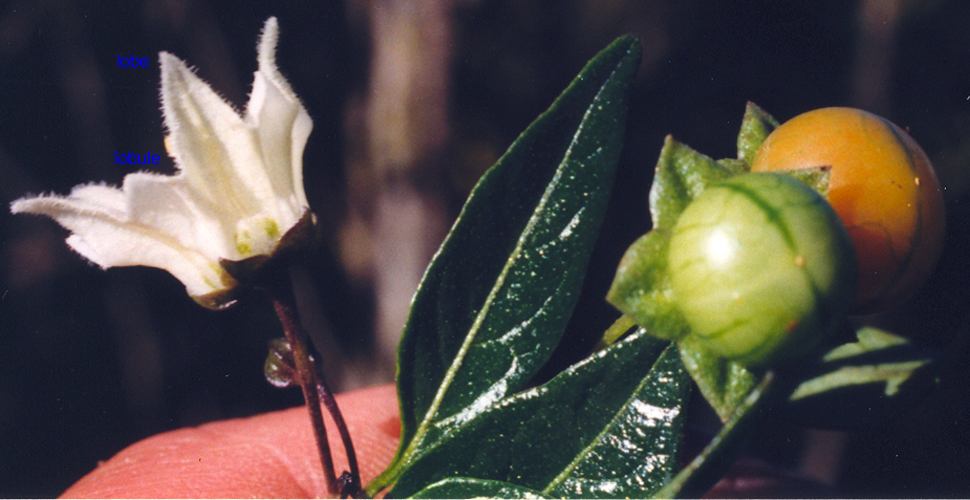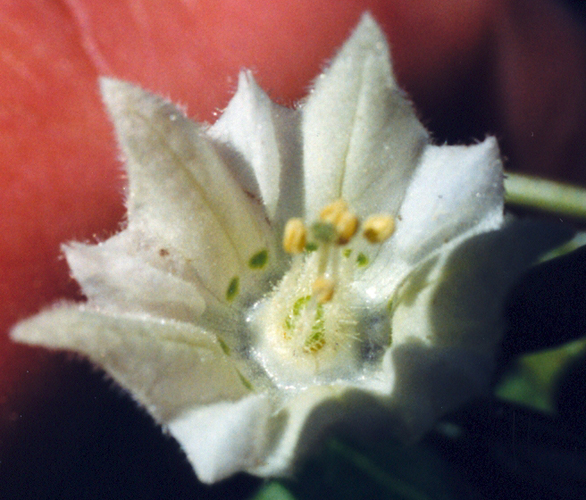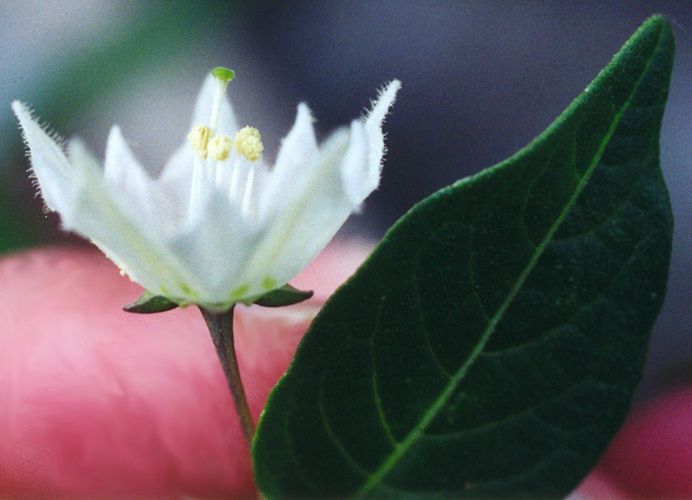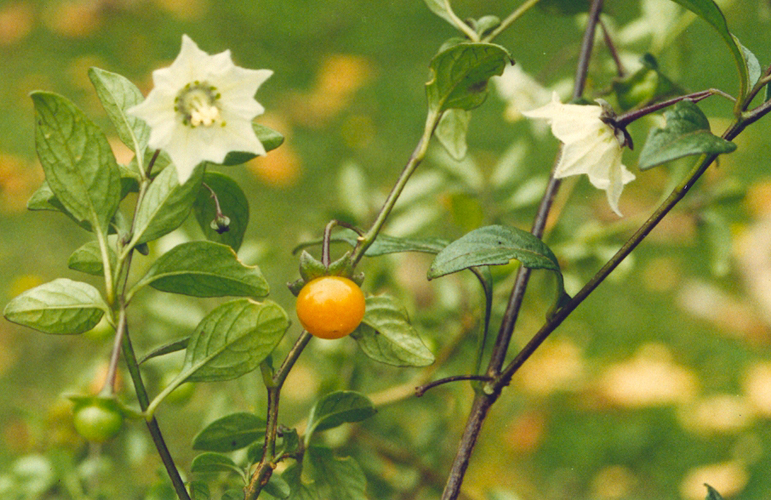
Figure 1. Jaltomata oppositifolia. Lustrousness of leaves is evident; corolla maculae (green) are evident through the base of the corolla
(photo taken in Peru by Thomas Mione, Mione, Leiva G. & Yacher 674)
Jaltomata oppositifolia S. Leiva & Mione |
Peru |
revised Aug 2023 |
| Link to Jaltomatahomepage | The information on this page may be cited as a communication with professor Thomas Mione, Central Connecticut State University, Biology Department, Copernicus Hall, 1615 Stanley Street, New Britain, Connecticut 06050-4010, United States of America. | Novon 17: 49-58. 2007 |
| Links to the Jaltomata of Cajamarca, Peru, and northern Peru |
 |
Figure 1. Jaltomata oppositifolia. Lustrousness of leaves is evident; corolla maculae (green) are evident through the base of the corolla |
| See the Jaltomata huancabambae page for a table comparing this taxon with taxa that are most similar. Comparison with J. salpoensis is not in the table but is presented here: Jaltomata oppositifolia has an upright habit, conspicuous corolla lobules, stamens are 5--6.5 mm long, anthers are yellow, and the style is 6.5--8 mm long. Jaltomata salpoensis, on the other hand, is sometimes prostrate, the crateriform corolla lacks lobules, stamens are 2.5--3 mm long, anthers are white, and the style is two mm long (Leiva & Mione, 1999). |
 |
Figure 2. Jaltomata oppositifolia Corolla maculae (green)
Photo by Thomas Mione in Peru Mione, Leiva G. & Yacher 674
|
Table 1. Description of Jaltomata oppositifolia.
| Character | Description of Jaltomata oppositifolia | Figures |
Habit & Height |
Shrub to 1.2 m high, learning on other vegetation or erect | |
Branches, young |
nearly terete, purple | |
older |
woody, terete, glabrous, to 2 cm in diameter, brown | |
| Leaves, size | usually geminate, to 4 X 1.7 cm, lustrous, coriaceous | |
| shape | the blade eliptic to lanceolate, the apex acute, the margin entire | |
| hairs | glabrous, the margin ciliolate | |
| petiole | 7-10 mm long | |
Inflorescence |
axillary, with 2- (3 buds) flowers per inflorescence | |
peduncle |
8--17 mm, terete, purple, glabrous | |
pedicel |
8--17 mm, somewhat angular, purple, glabrous | |
| Calyx when flowering: color, size | green, 6.5 - 8 mm across | |
| shape / position during anthesis | nearly rotate during anthesis, the lobes deltoid | |
| hairs | glabrous except for scattered glands on both faces, the margin ciliolate | |
| at fruit maturity | at fruiting to 17 mm across | |
Corolla color |
white with two green maculae flanking the radial vein extending to the tip of each lobe | |
shape and size |
crateriform-infundibular (broadly infundibular to rotate, protologue), 12--13 mm across | |
lobes/lobules |
10-lobed: 5 lobes alternating with 5 lobules, the lobes triangular | |
hairs |
adaxially glabrous on herbarium specimens but pilosulose with gland-tipped finger hairs 0.1 mm long on fresh specimens, abaxially with glands, the margin ciliate with finger hairs 0.5 mm long. | |
| no | dissecting microscope was used 2012, Mione et al. 674 |
|
| Stamen length | 5 - 6.5 mm long | |
| filaments | off-white, pubescent on proximal 55--70% of the length with unpigmented finger hairs | |
| anther color | yellow | |
| anther size | Length measured with dissecting microscope after stored in 70% ethanol: 1.65 - 1.74 mm X 1.7 wide. Length measured with dissecting microscope, pressed specimens: 1.05 - 1.2 mm. | |
| anther mucronate/mucronulate | no | |
| insertion of filament into anther | ||
| anthers of a flower open simultaneously? | ||
| pollen quantity per flower | 56,000 (n = 1 androecium) | Mione et al. 674, count by Emmett P. Varricchio, 2012, flower collected in Peru (not grown for study) |
| pollen grain size | 32.5 - 37.5 µm, mean 34.8 µm |
Mione et al. 674, 15 grains, Michael J. Tanasi, 2012, flowers collected in Peru (not grown for study) |
| corona | no | |
Stigma |
capitate, shallowly bilobed (obscured by pressing), green, 0.51--0.84 mm, exserted 2--2.4 mm beyond corolla; gynoecium glabrous except for stigma papillae 40 µm long | 3, 5 |
Style |
6.5--8 mm long, off-white | 5 |
Ovary |
disk girdling base of ovary | |
Ovules per ovary |
81 (n = 1 flower) | ovules of both locules were counted; flower collected in Peru (not grown for study) |
| Nectar | ||
| Herkogamy | yes (plants grown in Connecticut) | 3 |
| Protogyny | ||
Fruit color (at maturity) and size |
subspherical, orange, to 12 mm across at maturity | |
Seeds per fruit |
to 106 per fruit | |
Seed Size |
1.45 X 1.15 X 0.45 mm | |
Chromosome number |
no data |
|
Growability in Connecticut, USA |
no data |
|
How long does it take from flower to ripe fruit? |
no data |
|
Self-Compatible? |
no data |
|
Seed Germination |
no data |
|
| Ratio of pollen to ovules | 691 (56,000 / 81 ovules, n = 1 flower) | |
| Character | Description of Jaltomata oppositifolia | Figures |
Distribution, ecology, and etymology. Jaltomata oppositifolia is known from the type locality and from near the small town of Paraguay, both in Peru, department of Cajamarca, province Chota, between 2,250 and 3,090 m. This species grows in secondary growth and near streams, but is not common. At the type locality it grows at the edge of one of the last remaining old-growth forests we saw in the region. This forest, Bosque El Pargo, was being cut for wood and agriculture when we visited in 1999. This species flowers and fruits in March, May, June and August. The specific epithet derives from the apparent phyllotaxy. |
| locality | elev m |
habitat | date | collector | listed as J. oppositifolia in S. Leiva's master's thesis (1998) |
in protologue | data entry |
|---|---|---|---|---|---|---|---|
| Bosque el Pargo (between Llama & Huambos), 6 28 17 S, 79 03 22 W | 3050 | border of cultivated fields and forest | 19 June 1999 |
S. Leiva G., T. Mione & L. Yacher 2376 (holotype, HAO; isotypes, C, CORD, MO) |
not applicable because collected after | yes | April 2009 |
| collected at same time and place as the type specimen | 3050 | border of cultivated fields and forest | 19 June 1999 |
Mione, Leiva G. & Yacher 674 (MO) | not applicable because collected after | yes | October 2018 |
| Bosque el Pargo (between Llama & Huambos) | 3090 | Terreno después de talado y quemado | 14 Aug 1994 | S. Leiva G., P. Chuna & J. Cadle 1523 (F, HAO) |
no | yes | October 2018 |
| bosque El Pargo (arriba de Huarimarca), Llama-Huambos | 3000 | bosque húmedo | 18 March 1997 | A. Sagástegui A., S. Leiva G. & V. Quipuzcoa 15996 (HAO, US) |
no | yes | October 2018 |
| a 1 km del poblado de Paraguay (between Querocoto & La Granja) | 2250 | Borde de río | 7 August 1994 | S. Leiva G., P. Chuna & J. Cadle 1380 (CORD, F, HAO). | yes | yes | October 2018 |
 |
Figure 3 Jaltomata oppositifolia photo by Thomas Mione at the University of Connecticut Greenhouse, of plants grown from seeds of Mione, Leiva G. & Yacher 674
note: stigma exserted beyond dehisced anthers (herkogamy) |
 |
Figure 4 Jaltomata oppositifolia
photo by |
| Figure 5. Style and stigma (shallowly bilobed) of Jaltomata oppositifolia. Units along bottom are mm; Mione et al. 674, photo by Thomas Mione, July 2012, after flower was stored in spirits for years, field collected (not from a plant grown for study). |